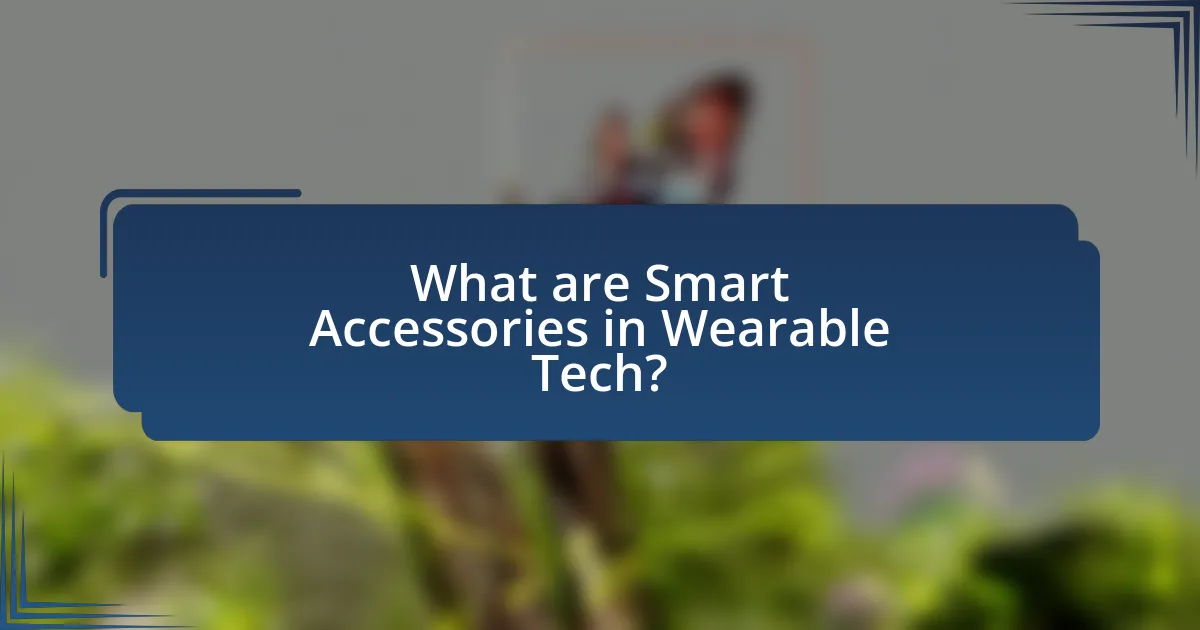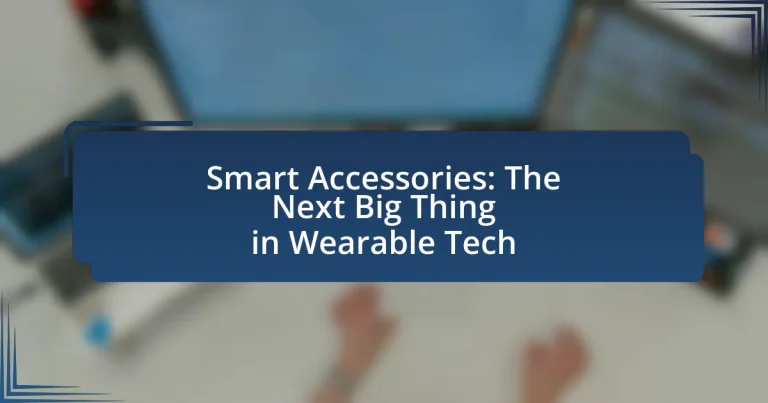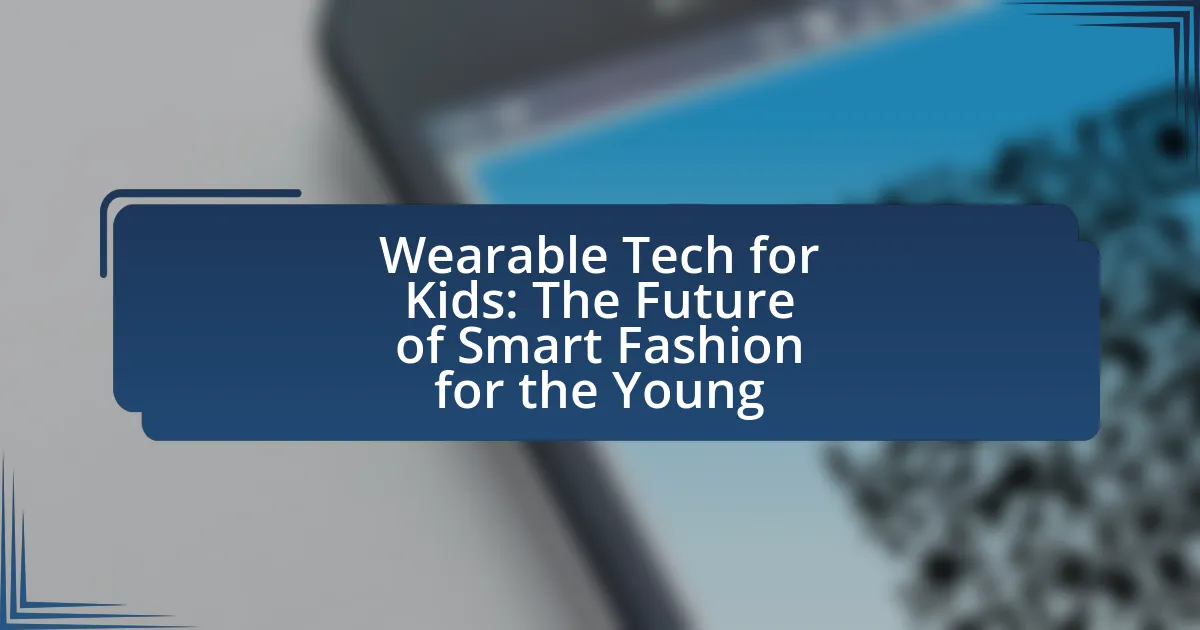Smart accessories in wearable technology are devices designed to enhance the functionality of primary wearables, such as smartwatches and fitness trackers, by providing additional features and improving user experience. These accessories include smart bands, clips, and specialized cases that offer capabilities like extended battery life and enhanced health monitoring. The article explores the differences between smart accessories and traditional wearables, their defining features, and the growing popularity driven by advancements in technology and consumer demand. It also discusses various types of smart accessories, their benefits, challenges users face, and future trends in the market, emphasizing the importance of connectivity and sensor technology in maximizing user experience.

What are Smart Accessories in Wearable Tech?
Smart accessories in wearable tech are devices that enhance the functionality of primary wearables, such as smartwatches and fitness trackers, by providing additional features or improving user experience. These accessories can include items like smart bands, clips, and specialized cases that integrate with existing wearable technology to offer capabilities such as extended battery life, enhanced connectivity, or additional health monitoring features. For instance, smart bands can track specific health metrics like heart rate variability or sleep patterns, complementing the data collected by a smartwatch. The integration of these accessories is supported by the growing ecosystem of wearable technology, which is projected to reach a market size of over $60 billion by 2023, indicating a significant demand for innovative enhancements in this sector.
How do Smart Accessories differ from traditional wearables?
Smart accessories differ from traditional wearables primarily in their integration and functionality. While traditional wearables, such as fitness trackers and smartwatches, focus on health monitoring and notifications, smart accessories enhance everyday items, like jewelry or clothing, with technology that seamlessly blends into daily life. For instance, smart rings can track health metrics without the bulk of a smartwatch, and smart glasses can provide augmented reality experiences. This integration allows for more discreet and versatile use, catering to a broader range of consumer preferences and lifestyles.
What features define Smart Accessories?
Smart accessories are defined by their ability to integrate technology with everyday items, enhancing functionality and user experience. Key features include connectivity, allowing devices to sync with smartphones or other gadgets; sensors that monitor health metrics or environmental conditions; and smart interfaces that enable user interaction through touch or voice commands. For instance, smartwatches can track heart rate and steps while providing notifications from a connected phone, demonstrating the practical application of these features in daily life.
Why are Smart Accessories gaining popularity?
Smart accessories are gaining popularity due to their ability to enhance convenience and connectivity in daily life. These devices, such as smartwatches, fitness trackers, and smart jewelry, integrate seamlessly with smartphones and other technology, allowing users to monitor health metrics, receive notifications, and control smart home devices. According to a report by Statista, the global wearable technology market is projected to reach over $60 billion by 2023, indicating a significant consumer interest in these products. This growth is driven by advancements in technology, increased health awareness, and the desire for personalized experiences, making smart accessories an appealing choice for modern consumers.
What types of Smart Accessories are available?
Smart accessories include a variety of devices designed to enhance user experience and connectivity. Common types of smart accessories are smartwatches, fitness trackers, smart glasses, smart jewelry, and smart home devices. For example, smartwatches like the Apple Watch and Samsung Galaxy Watch provide notifications, health tracking, and app integration. Fitness trackers such as Fitbit monitor physical activity and health metrics. Smart glasses, like Google Glass, offer augmented reality features, while smart jewelry combines aesthetics with technology for notifications and health monitoring. Smart home devices, including smart speakers and smart plugs, enable remote control and automation of home functions. These accessories are increasingly popular due to their ability to integrate seamlessly with smartphones and other devices, enhancing convenience and functionality in daily life.
What are the most common categories of Smart Accessories?
The most common categories of smart accessories include smartwatches, fitness trackers, smart glasses, smart jewelry, and smart home devices. Smartwatches, such as the Apple Watch and Samsung Galaxy Watch, provide notifications, health tracking, and app integration. Fitness trackers, like Fitbit and Garmin devices, focus on monitoring physical activity and health metrics. Smart glasses, exemplified by Google Glass and Snapchat Spectacles, offer augmented reality experiences. Smart jewelry, including devices like Oura Ring, combines fashion with health tracking. Lastly, smart home devices, such as smart speakers and smart thermostats, enhance home automation and connectivity. These categories reflect the growing trend of integrating technology into everyday accessories for improved functionality and convenience.
How do different Smart Accessories serve various user needs?
Different smart accessories serve various user needs by providing tailored functionalities that enhance daily activities and improve user experience. For instance, smartwatches offer health monitoring features such as heart rate tracking and fitness tracking, catering to users focused on wellness and fitness. Smart glasses provide augmented reality experiences, appealing to users interested in immersive technology for gaming or navigation. Additionally, smart home devices like smart speakers and smart thermostats address convenience and energy efficiency needs, allowing users to control their environment seamlessly. These accessories are designed based on user feedback and market research, demonstrating their effectiveness in meeting specific demands.
What technologies power Smart Accessories?
Smart accessories are powered by technologies such as Bluetooth, NFC (Near Field Communication), and various sensors including accelerometers and gyroscopes. Bluetooth enables wireless communication between devices, allowing smart accessories to connect seamlessly with smartphones and other gadgets. NFC facilitates quick data transfer and payment options, enhancing user convenience. Additionally, sensors like accelerometers and gyroscopes provide motion tracking and health monitoring capabilities, which are essential features in wearable technology. These technologies collectively enhance functionality and user experience in smart accessories.
How do sensors enhance the functionality of Smart Accessories?
Sensors enhance the functionality of Smart Accessories by enabling real-time data collection and interaction with the environment. These sensors, such as accelerometers, gyroscopes, and heart rate monitors, allow devices to track user activity, monitor health metrics, and provide personalized feedback. For instance, a fitness tracker uses a heart rate sensor to measure cardiovascular performance, which can inform users about their fitness levels and suggest improvements. This capability is supported by research indicating that wearable devices with integrated sensors can improve user engagement and health outcomes, as evidenced by a study published in the Journal of Medical Internet Research, which found that users of fitness trackers reported increased physical activity levels.
What role does connectivity play in Smart Accessories?
Connectivity is essential in Smart Accessories as it enables seamless communication between devices and enhances functionality. Smart Accessories rely on connectivity to transmit data, receive updates, and interact with other smart devices, creating a cohesive ecosystem. For instance, wearable fitness trackers utilize Bluetooth to sync with smartphones, allowing users to monitor health metrics in real-time. This interconnectedness not only improves user experience but also facilitates data collection for personalized insights, demonstrating the critical role of connectivity in maximizing the potential of Smart Accessories.

What are the benefits of using Smart Accessories?
Smart accessories enhance user experience by providing convenience, connectivity, and functionality. These devices, such as smartwatches and fitness trackers, allow users to monitor health metrics, receive notifications, and control other smart devices seamlessly. For instance, a study by the Pew Research Center found that 69% of adults in the U.S. use at least one smart device, highlighting the growing reliance on technology for daily tasks. Additionally, smart accessories often integrate with mobile applications, enabling personalized insights and improved decision-making, which can lead to better health outcomes and increased productivity.
How do Smart Accessories improve daily life?
Smart accessories improve daily life by enhancing convenience, connectivity, and health monitoring. These devices, such as smartwatches and fitness trackers, allow users to receive notifications, track physical activity, and monitor vital signs in real-time. For instance, a study published in the Journal of Medical Internet Research found that wearable devices can significantly increase physical activity levels among users, leading to improved overall health. Additionally, smart accessories often integrate with smartphones and home automation systems, streamlining daily tasks and improving time management. This integration supports a more efficient lifestyle, as users can control various aspects of their environment with ease.
What health benefits can Smart Accessories provide?
Smart accessories provide several health benefits, including monitoring vital signs, tracking physical activity, and promoting better sleep quality. These devices, such as fitness trackers and smartwatches, can measure heart rate, blood pressure, and oxygen levels, allowing users to gain insights into their health status. For instance, a study published in the Journal of Medical Internet Research found that wearable devices significantly improve physical activity levels among users, leading to better overall health outcomes. Additionally, smart accessories can analyze sleep patterns, helping users identify issues and improve their sleep hygiene, which is crucial for mental and physical well-being.
How do Smart Accessories enhance productivity?
Smart accessories enhance productivity by automating tasks and providing real-time data, which allows users to focus on their core responsibilities. For instance, smartwatches can manage notifications, track fitness, and monitor schedules, reducing the need to constantly check smartphones. Research indicates that wearable technology can increase workplace efficiency by up to 34% by streamlining communication and task management. Additionally, smart accessories like smart glasses can facilitate hands-free operation, enabling users to multitask effectively.
What challenges do users face with Smart Accessories?
Users face several challenges with Smart Accessories, including connectivity issues, battery life limitations, and compatibility concerns. Connectivity problems often arise due to inconsistent Bluetooth or Wi-Fi connections, which can disrupt the functionality of these devices. Battery life is another significant challenge, as many smart accessories require frequent charging, limiting their usability throughout the day. Additionally, compatibility issues can occur when smart accessories do not seamlessly integrate with existing devices or platforms, leading to a fragmented user experience. These challenges highlight the need for improved technology and user-friendly designs in the development of smart accessories.
What are common technical issues with Smart Accessories?
Common technical issues with Smart Accessories include connectivity problems, battery life limitations, software bugs, and compatibility issues with other devices. Connectivity problems often arise due to weak Bluetooth or Wi-Fi signals, which can disrupt the communication between the accessory and the paired device. Battery life limitations are frequently reported, as many smart accessories require frequent charging due to high power consumption. Software bugs can lead to malfunctions or unexpected behavior, impacting user experience. Compatibility issues may occur when accessories do not work seamlessly with certain operating systems or devices, limiting their functionality. These issues are documented in user reviews and technical support forums, highlighting the challenges faced by consumers in utilizing smart accessories effectively.
How can users ensure the longevity of their Smart Accessories?
Users can ensure the longevity of their Smart Accessories by following proper care and maintenance practices. Regularly updating the device’s software helps to fix bugs and improve performance, which can extend its lifespan. Additionally, users should avoid exposing their accessories to extreme temperatures, moisture, and physical damage, as these factors can significantly reduce durability. Cleaning the accessories with appropriate materials, such as microfiber cloths, prevents dirt buildup that can impair functionality. According to a study by the Consumer Technology Association, proper maintenance can increase the lifespan of electronic devices by up to 30%.
What is the future of Smart Accessories in wearable tech?
The future of smart accessories in wearable tech is poised for significant growth, driven by advancements in connectivity, artificial intelligence, and user personalization. As of 2023, the global wearable technology market is projected to reach $60 billion by 2025, indicating a robust demand for smart accessories such as smartwatches, fitness trackers, and augmented reality glasses. These devices are increasingly integrating health monitoring features, such as continuous glucose monitoring and heart rate tracking, which cater to the rising consumer focus on health and wellness. Furthermore, the incorporation of AI allows for enhanced user experiences through personalized recommendations and predictive analytics, making smart accessories more intuitive and user-friendly.
How are advancements in technology shaping Smart Accessories?
Advancements in technology are significantly shaping Smart Accessories by enhancing their functionality, connectivity, and user experience. For instance, the integration of artificial intelligence allows smart accessories to learn user preferences and adapt accordingly, improving personalization. Additionally, the development of low-power sensors and improved battery technology enables longer usage times and more compact designs, making devices like smartwatches and fitness trackers more efficient and user-friendly. According to a report by Statista, the global market for wearable technology is projected to reach $62 billion by 2025, highlighting the growing impact of technological advancements on smart accessories.
What trends are emerging in the Smart Accessories market?
Emerging trends in the Smart Accessories market include increased integration of artificial intelligence, enhanced health monitoring capabilities, and a focus on sustainability. The integration of AI allows for personalized user experiences, enabling devices to learn and adapt to individual preferences. Enhanced health monitoring features, such as advanced biometric sensors, are becoming standard, driven by consumer demand for real-time health data. Additionally, sustainability is gaining traction, with manufacturers prioritizing eco-friendly materials and production processes to appeal to environmentally conscious consumers. These trends reflect a shift towards more intelligent, health-focused, and environmentally responsible smart accessories.

How can users maximize their experience with Smart Accessories?
Users can maximize their experience with Smart Accessories by ensuring compatibility with their devices and regularly updating the software. Compatibility allows seamless integration, enhancing functionality and user experience. Regular software updates provide access to new features, security enhancements, and improved performance, which are crucial for optimal use. For instance, a study by the Consumer Technology Association found that users who keep their devices updated experience 30% fewer technical issues, leading to a more satisfying interaction with their smart accessories.
What best practices should users follow when using Smart Accessories?
Users should follow several best practices when using Smart Accessories to ensure optimal performance and security. First, regularly update the firmware and software of the accessories to protect against vulnerabilities; studies show that outdated software can lead to security breaches. Second, users should connect Smart Accessories to secure Wi-Fi networks rather than public ones, as unsecured networks increase the risk of unauthorized access. Third, users should familiarize themselves with the privacy settings of their devices, as many accessories collect personal data; understanding these settings can help users control what information is shared. Additionally, users should charge their devices using the recommended chargers to prevent battery damage, as improper charging can reduce the lifespan of the accessories. Lastly, users should read the user manuals thoroughly to understand the features and limitations of their Smart Accessories, ensuring they maximize their utility while minimizing risks.
How can users troubleshoot common issues with Smart Accessories?
Users can troubleshoot common issues with Smart Accessories by following a systematic approach. First, they should ensure that the accessory is fully charged and properly connected to the device, as many issues stem from low battery or connectivity problems. Next, users should check for software updates for both the accessory and the paired device, as outdated software can lead to compatibility issues. Additionally, resetting the accessory to factory settings can resolve persistent problems, as this clears any glitches. Users can also refer to the manufacturer’s troubleshooting guide, which often includes specific steps for common issues. According to a survey by the Consumer Technology Association, 70% of users found that following manufacturer guidelines effectively resolved their issues, highlighting the importance of utilizing available resources.
What tips can enhance the functionality of Smart Accessories?
To enhance the functionality of Smart Accessories, users should regularly update the device firmware and software to ensure optimal performance and security. Keeping software current allows access to new features and improvements, as manufacturers often release updates that fix bugs and enhance compatibility with other devices. Additionally, integrating Smart Accessories with a centralized app can streamline control and customization, allowing users to tailor settings to their preferences. Research indicates that user engagement with companion apps significantly increases the utility of wearable technology, as seen in studies by the International Journal of Human-Computer Interaction, which highlight improved user satisfaction and functionality through effective app integration.





